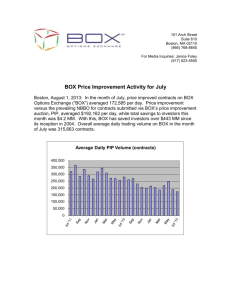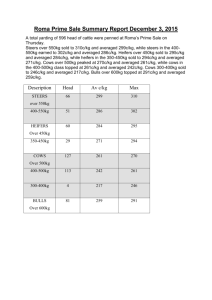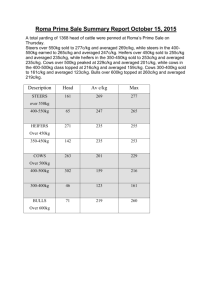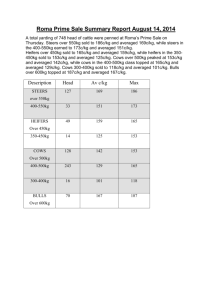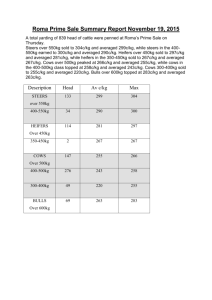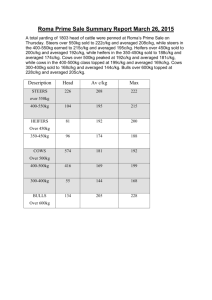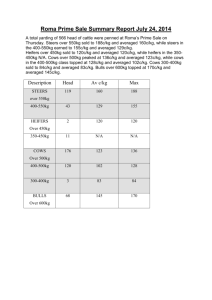Flow, Sediment, and Nutrient Transport in a Riparian Mangrove
advertisement
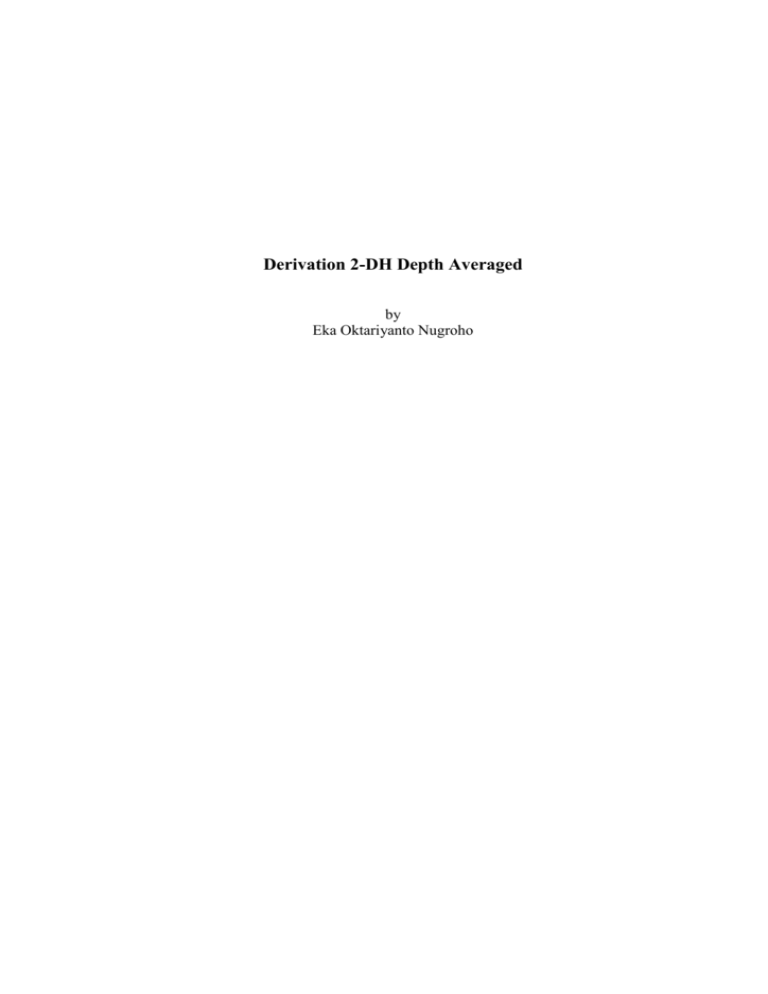
Derivation 2-DH Depth Averaged by Eka Oktariyanto Nugroho Basic Equation 7 Eka O. N. 7.1. GENERAL CONSIDERATIONS Basic assumptions to derivate the 2 Dimensional Horizontal Depth Averaged for shallow water problem are : Incompressible Turbulent time averaged A key assumption for depth averaging is that the flow in the vertical direction is small This implies that all terms in the Z-direction Reynolds Equation are small compared to the gravity and pressure terms. Thus the Z-direction Reynolds Equation reduces to p g This implies that the pressure distribution over the vertical is hydrostatic z Scetch Conditions Figure 7. 1 Illustration for depth averaged velocity distribution. z 0 , the free surface (water-air interface) at z , and the bottom (water-sediment interface) at z h Consider the geoid to be defined at Depth Averaged velocities are defined as: uU 1 h udz vV h 1 h vdz ................................................................. (7-1) h The total water column height is defined as: H h Flow rate over the vertical is defined as: qx udz uH and qy h vdz vH ................................................................... (7-2) h The Continuity equation is: u v w 0 .........................................................................................................................................................(6-2) x y z The Momentum equation is: u u u u 1 p 1 xx 1 yx 1 zx u v w t x y z 0 x 0 x 0 y 0 z Derivation 2-DH Depth Averaged ....................... (6-3) or (6-4) Page - 52 Basic Equation 7 Eka O. N. Boundary conditions are: 1. Free surface condition S(x,y,z,t)= η (x,y,t)-z = 0, pada z = η dS 0: dt dS x y z 0 dt t x t y t t u v w 0 t x y w z D Dt z u v ................................................................. (7-3) z z t x y ..................................................................................... (7-4) u v w y x z t 2. Bottom surface condition S = z0 – z = 0 , at z = z0 S(x,y,z,t)= -z0 (x,y,t)-z = 0 with dS 0: dt dS z0 z0 x z0 y z 0 dt t x t y t t z0 z z u(x, y, z0 ) 0 v(x, y, z 0 ) 0 w(x, y, z 0 ) 0 at z = z0 t x y The velocity in the bottom is: U(-h) = V(-h) = W(-h) = 0, then w z h D h Dt h z h t u h z h x v h 0 t h z h y ......................................... (7-5) h h v w 0 ...................................................................................... (7-6) u x y z h Derivation 2-DH Depth Averaged Page - 53 Basic Equation 7 Eka O. N. 7.2. CONTINUITY DEPTH AVERAGED EQUATION u v w 0 .........................................................................................................................................................(6-2) x y z Vertically average 1 H u w v x y z dz 0 h Multiplying through by H and evaluating the last integral: x , y ,t x , y ,t u v w u v w h x y z dz h x, y,t x dz h x, y ,t y dz h z dz 0 x , y ,t x , y ,t u v dz dz w w h 0 x y h x , y ,t h x , y ,t Using Leibnitz’s Rule: B x , y ,t F dz Fdz F x x a A x , y ,t b z A A F x zB B x ...............................................................................................(7-7) Hence eq. (6.2) become u h h x dz x h udz u z h x u z x h v h y dz y h vdz v zh y v z y w z dz w h z w z h h h udz vdz u v w u v w 0 x h y h y x y x z z h (7-8) With bottom and free surface condition, eq (7-4) and (7-6) udz vdz 0 t x h y h Terms (7-9) udz and h vdz in eq. (7-9) are called depth averaged velocity, U and V , substitute by h equation (7.2) hence u v w x y z dz t h qx q y 0 ........................................................................................................... (7-10) x y Derivation 2-DH Depth Averaged Page - 54 Basic Equation 7 Eka O. N. where H = h + η. Because h is contant, then h 0. t Depth Averaged Continuity Equation : d vH H uH 0 ............................................................................................................................................. (7-11) t x dy Or d vH uH 0 .............................................................................................................................................. (7-12) t x dy 7.3. MOMENTUM DEPTH AVERAGED EQUATION Consider the X-direction Reynolds equation: u u u u 1 p 1 xx 1 yx 1 zx u v w t x y z 0 x 0 x 0 y 0 z ................................ (6-3) or (6-4) 'ij u i u ' j u 'i x j 'ij ui 0 u ' j u 'i x j xx u u u 0 u ' u ' , yx 0 u ' w ' 0 u ' v ' , zx x z y And p g , integrating this equation between the free surface at z and some level z z p x , y , z z p ps x , y gz where ps = pressure at the free surface z And assuming that density is constant: p ps gz g p ps g gz 1 p 1 ps z g g x x x x The surface pressure does not vary spatially: 1 p g x x or z 1 p g g 0 g gs0 x x x x Where s0= channel bottom slope Depth averaged equation form for the above equation is: u u u u 1 xx 1 yx 1 zx u v w g t x y z x x y z Derivation 2-DH Depth Averaged Page - 55 Basic Equation 7 Eka O. N. By adding u times the continuity equation to the above equation: u u u u u v w 1 xx 1 yx 1 zx u v w u u u g t x y z x y z x x y z Re-arranging 2 uv uw u u 1 xx yx zx g t x y z x x y z yx du uu uv uw 1 dz dz dz dz g dz h dt h x h y h z h x h xxx y zzx term 1 term 2 term 3 term 4 term 5 dz ......... (7-13) term 6 Using Leibnitz’s Rule: x , y ,t Where f dz f dz f t t h h x , y ,t t z f h z h t ...............................................................................(7-7) 2 f u, u , uv, , xx , xy and g h z dz h g g z g z h Where g uw, zx Term 1 d d h u h t dz t h udz u z dt u z h dt Term 2 2 2 uu dz u z u h x x h d z dx u d h 2 z h dx Term 3 d d h uv h x dz x h uvz uv z dx uv z h dx Term 4 uw h z dz uw h w z w z h Derivation 2-DH Depth Averaged Page - 56 Basic Equation 7 Eka O. N. Term 5 h g dz g dz g z g z h x x h x x h Term 6 yx 1 h xxx y zzx 1 1 dz dz dz x h xx y h yx h h 1 1 xx yx zx xx yx zx x y x y z z h Rewrite Equation 7.13 becomes: du uu uv dz dz h dt h x h y dz u t u x v y w z h h h u v w x y t z h g ................................................ (7-14) h 1 1 dz g g xx dz dz x h x x x h y h yx h h 1 1 xx yx zx xx yx zx x y x y z z h The boundary condition is done with equation 7-4 and 7-6. By performing a stress balance at the surface, it can be shown that xs applied surface stress in the x direction and parallel to the surface. xs 1 xx yx zx x y z Similarly at the bottom: xb h h 1 yx zx xx x y z h Substituting reduces the X-momentum equation to: du uu uv h dt dz h x dz h y dz h 1 xs xb 1 g dz g g dz dz xx yx x h x x x h y h ................... (7-15) We define the depth averaged variable as: 1 H dz h The Reynolds averaged quantity is then defined as the sum of the depth averaged variable and the deviation from the depth averaged variable ˆ Derivation 2-DH Depth Averaged Page - 57 Basic Equation 7 Eka O. N. Thus we define velocities in terms of the depth averaged quantity and the deviation from the depth averaged quantity The spatial averaging is applied as: udz H u h vdz H v h Furthermore we let: u x, y, z, t u x, y, z, t uˆ x, y, z , t v x, y, z, t v x, y, z, t vˆ x, y, z , t This implies that: h h ˆ 0 and udz ˆ 0 vdz Hence uudz h 2 2 h uudz u 2 h u 2uu u z h h 2 z 2u uz u z h 2 uudz H u u z 2 h h Similarly h h h h h uvdz uv uv uv uv dz uvH uvdz dz dz H Substituting and re-arranging: Hu Hu t x g 2 H uv y H x g ..... (7-16) 2 h xx yx g u dz uv dz x x x h y h s x b x Expanding the terms involving gravity g H x g H h h g g H x x x x x Derivation 2-DH Depth Averaged .............................................................. (7-17) Page - 58 Basic Equation 7 Eka O. N. g H x g h g gH x x x We also note that the acceleration terms can be expanded as: u H H u Hu t t t u h H u Hu t t u H u t Hu t t t u H u H u u Hu 2 x H uv y x x y y u H v H v u Substituting in the gravity and acceleration term re-arrangements: u u u H u H v H Hu Hv u t x x x y t gH ................................................ (7-18) 2 xs xb xx yx u dz uv dz x x h y h It is clear that the depth averaged continuity equation is embedded in the previous equation and therefore drops out. Dividing through by H will result in the depth averaged conservation of momentum equation in non-conservative form. 2 u u u 1 xx 1 yx 1 xs 1 xb u v g u dz uv dz t x x x H x h H y h H H or 2 u u u 1 xx 1 yx 1 xs 1 xb u v g gs0 u dz uv dz t x x x H x h H y h H H ......................................................................................................................................................................................................... (7.19) s b 2 v v v 1 xy 1 yy 1 y 1 y u v g uv dz v dz t x x y H x h H y h H H ......................................................................................................................................................................................................... (7.20) Derivation 2-DH Depth Averaged Page - 59 Basic Equation 7 Eka O. N. Otherwise For X direction, eq. (6-3 or 6-4): du uu uv uw 1 p 1 xx yx zx dt x y z x x y z Depth averaged equation form for the above equation is: du uu uv uw h dt dz h x dz h y dz h z dz 1 p 1 xx 1 yx 1 zx dz dz dz dz x x y z h h h h ..................................................... (7-21) with p g z dp g g z dx x x ........................................................................................................................................ (7-22) Substitute eq. (7.22) to eq. (7.21), obtain: yx du uu uv uw 1 1 dz dz dz dz g dz h dt h x h y h z h x h xxx y zzx dz yx du uu uv uw 1 dz dz dz dz g dz h dt h x h y h z h x h xxx y zzx dz du uu uv uw h dt dz h x dz h y dz h z dz term1 term 2 term 3 term 4 yx zx g 1 g dz z dz xx dz x x x y z h h h term 5 term 6 .............................................. (7-23) term 7 Using Leibniz Rule’s: Term 1 d h d du d dz udz u h u h dt dt h dt dt 0 d d u h u dt dt d d u h u dt dt Derivation 2-DH Depth Averaged Page - 60 Basic Equation 7 Eka O. N. Term 2 d h 2 d uu d dz u 2 dz u 2 h u h x dx h dx dx 0 d d u 2 dz -u 2 dx h dx instance xx = 1 h u 2 u dz 2 h d d xx h u 2 u 2 dx dx Term 3 d h d uv d dz uvdz uv h uv h y dy h dy dy 0 d d uvdz uv dy h dy instance yx 1 = uvdz h uv h d d yx h uv uv dy dy Term 4 uw h z dz uw h uw uw h 0 Term 5 g dz g x x h h g h x Term 6 g g z dz x x h z dz h g 1 2 z z x 2 h g1 2 h 2 x Derivation 2-DH Depth Averaged Page - 61 Basic Equation 7 Eka O. N. Term 7 1 xx yx zx 1 h x y z dz xxx 1 yx y h h 1 zx h 1 xx 1 yx h h x y 1 1 zx zx h Re-arranging equation (7.23) d d d d 2 xx h u 2 u 2 u h u dt dt dx dx d d yx h uv uv dy dy g1 1 xx 1 yx 1 1 2 g h h h h zx zx h x 2 x x y ......................................................................................................................................................................................................... (7-24) d d d d d d 2 u h u xx h u u u yx h uv u v dt dx dx dy dy dt g1 1 xx 1 yx 1 1 2 g h h h h zx zx h x 2 x x y d d d d d d 2 u v u h xx h u yx h uv u dx dy dt dx dy dt g1 1 xx 1 yx 1 1 2 g h h h h zx zx h x 2 x x y d d d With u v =0 dt dx dy d d d 2 dt u h dx xx h u dy yx h uv g1 1 xx 1 yx 1 1 2 g h h h h zx zx h x 2 x x y h =H, h constant, h h H 0 hence . x x x x Boussinesq coefisien β =1 and Derivation 2-DH Depth Averaged H hence: x x Page - 62 Basic Equation 7 Eka O. N. d d 2 d dt uH dx u H dy uvH H g 2 1 xx 1 yx 1 1 gH H H H zx zx h x 2 x x y ........................... (7-25) 1 zx is define to surface shear stress, this stress is caused by wind: zx where: ρa C* Wx Wy a C * Wx W sx = water density = Ekman coefficient = 0.026 = wind velocity in X direction = wind velocity in Y direction W Wx Wy 1 zx h is define to bottom shear stress, this stress is caused by roughness effect of bottom channel, with Chezy Equation: zx h gUU C 2 bx Eq. (7.24) rewrite to: d d 2 d dt uH dx u H dy uvH H g 2 1 xx 1 yx a C *WxW g U U gH H H H x 2 x x y C2 ............................ (7-26) Similarly for Y direction. d d d 2 dt vH dx vuH dy v H H g 2 1 xy 1 yy a C *WyW g V V gH H H H y 2 y x y C2 With ( Ui ) ( U j ) 2 uiuj ˆ t k̂hij xi 3 xj i j, 1 i j, 0 where ij ............................ (7-27) ........................................................................ (7-28) u 2 kh u u u 2 x 3 v 2 yy 2 kh vv v2 y 3 w 2 zz 2 kh ww w2 z 3 xx 2 Derivation 2-DH Depth Averaged Page - 63 Basic Equation 7 Eka O. N. u v uv vu y x xy yx u w uw wu z x xz zx v w vw wv z y yz zy d d d dt uH dx uuH dy uvH u v C *WxW g U U H g 2 u 2 gH H 2 H kH H a x 2 x x x 3 C 2 y y x ......................................................................................................................................................................................................... (7-29) d d d dt uH dx uuH dy uvH u v s b H u 2 gH 2 H kH H x x x x x 3 y y x d d d dt uH dx uuH dy uvH H 1 xx 1 yx xs xb gH H H x x y ............................... (7-30) ................................................................................. (7-31) or d d d dt uH dx uuH dy uvH .............. (7-32) u v xs xb H u 2 gH Hgs0 2 H kH H x x x 3 y y x d d d dt uH dx uuH dy uvH H 1 xx 1 yx xs xb gH Hgs0 H H x x y Derivation 2-DH Depth Averaged ................................................................ (7-33) Page - 64 Basic Equation 7 Eka O. N. or d d d dt u dx uu dy uv . (7-34) H u v 1 xs 1 xb 1 u 2 1 g gs0 kH H 2 H x H x x 3 H y y x H H d d d H 1 xx 1 yx 1 xs 1 xb ......................... (7-35) u uu uv g gs 0 dt dx dy x x y H H Similarly for Y-direction: s b d d d H 1 xy 1 yy 1 y 1 y dt v dx uv dy vv g y x y H H ....................................... (7-36) Derivation 2-DH Depth Averaged Page - 65 Basic Equation 7 Eka O. N. 7.4. RESUME OF SHALLOW WATER EQUATION Resume of the governing equation for Shallow Water Equation are: d vH uH 0 t x dy 2 u u u 1 xx 1 yx 1 xs 1 xb u v g gs0 u dz uv dz t x x x H x h H y h H H s b 2 v v v 1 xy 1 yy 1 y 1 y u v g uv dz v dz t x x y H x h H y h H H The Shallow Water Equations were established in 1775 by Laplace. The momentum conservation statements are quite similar to the Reynolds equations with the following exceptions: Variables are now in depth averaged quantities. The Z-dimension has been eliminated. There are convective inertia forces caused by the flow deviation from the depth averaged velocities u , v . These equations have built into then 3 levels of averaging: Averaging over the molecular time/space scale. Averaging over the turbulent time/space scale. Averaging over the depth space scale. The latter two produce momentum transport terms that are intimately related to the convective terms. There are now three mechanisms of momentum transfer built into these equations: - u x dz type terms are the Viscous Stresses and represent the averaged effect of h molecular motions. These terms are necessary since we are not directly simulating momentum transfer via molecular level collisions. - u ' u 'dz type terms are the Turbulent Reynolds Stresses and represent the averaged h effect of momentum transfer due to turbulent fluctuations. These terms are necessary when using turbulent time averaged variables since we are not directly simulating momentum transfer via turbulent fluctuations. - uudz type terms represent the spreading of momentum over the water column. This h process is known as momentum dispersion. These terms are necessary since we are no longer directly simulating this process via the actual depth varying velocity profiles. They spread momentum laterally. The shallow water equations greatly simplify flow computation in free surface water bodies. Reduce the number of p.d.e.’s from 4 to 3. Reduce the complexity of the variables u x, y, t , v x, y, t , x, y, t instead of u x, y, z, t , v x, y, z, t , w x, y, z, t , p x, y, z, t Built-in positioning of the free surface boundary which is typically unknown when applying the Reynolds equations. Derivation 2-DH Depth Averaged Page - 66 Basic Equation 7 Eka O. N. The shallow water equations include 10 additional unknowns as compared to the Navier-Stokes eqautions. u ' u ', u ' v ', v ' v ' Lateral turbulent momentum diffusion uu , uv, vv Lateral momentum dispersion related to vertical velocity profile xs , ys Applied free surface stress xb , yb Applied bottom stress. It is related to the vertical velocity profile, momentum transport through the water column, bottom roughness. These 10 additional unknown require that 10 constitutive relationships are provided in order to close the system. Avery simple model for the combined lateral momentum diffusion (due to turbulence) and dispersion (due to averaging out vertical velocity profile) is: Hu 2 xx u dz E xx x h x Hv 2 yy v dz E yy x h y Hu Hv xy uv dz E xy x h x y Exx , E yy , Exy are called the eddy dispersion coefficients. This model assumes that the dispersion process dominates the turbulent momentum diffusion process which dominates the molecular diffusion process. In a typical gravity-driven open channel flow, the lateral momentum dispersion terms do not play a major role in the momentum balance equations, they can be neglected. Bottom stress is closed by the empirical relationships: c u v 2 2 xb cf u v b y 2 f 12 2 12 u v Where: cf = friction factor 1 f DW 8 g cf 2 c cf cf n2 g h1 3 Darcy Weisbach Chezy Manning Derivation 2-DH Depth Averaged Page - 67 Basic Equation 7 Eka O. N. SDS-2DH LES From 1. Turbulent Shear Flows in Shallow Open Channels with training Structures, Dissertation Chen, Fei-Yong 2. Organized Horizontal Vortices and Lateral Sediment Transport in Compound Channel Flows, Ikeda S., Sano T., Fukumoto M., and Kawamura K. h uh vh 0 t x y cf u u u h 1 u 2 1 v u u v g gs0 f x u u 2 v 2 t h 2t h kh t x y x h h x x 3 h y x y cf v v v h 1 v 2 1 v u u v g f y v u 2 v2 t h 2t h kh t x y y h h y y 3 h x x y acd u u 2 v2 h ac f y d v u 2 v2 h k k k 1 t k 1 t k h h pkh pkv t x y h x k x h y k y k2 t c fx c 3 4 l h k3 2 l 2 2 u 2 v u v pkh t 2 2 x y y x 32 c f ac pkv d u 2 v 2 2 h 1. 2. 3. 4. 5. 6. What LES Scheme for Numerical Explicit or Implicit Boundary Condition Fortran or other Convergent criteria Derivation 2-DH Depth Averaged Page - 68
